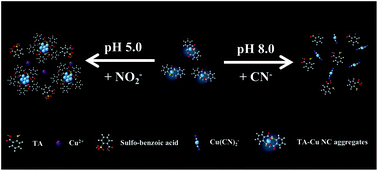当前位置:
X-MOL 学术
›
Anal. Methods
›
论文详情
Our official English website, www.x-mol.net, welcomes your feedback! (Note: you will need to create a separate account there.)
Control of pH for separated quantitation of nitrite and cyanide ions using photoluminescent copper nanoclusters
Analytical Methods ( IF 3.1 ) Pub Date : 2017-08-17 00:00:00 , DOI: 10.1039/c7ay01300k Jinshun Cang,Chia-Wei Wang,Po-Cheng Chen,Yi-Jyun Lin,Yu-Chi Li,Huan-Tsung Chang
Analytical Methods ( IF 3.1 ) Pub Date : 2017-08-17 00:00:00 , DOI: 10.1039/c7ay01300k Jinshun Cang,Chia-Wei Wang,Po-Cheng Chen,Yi-Jyun Lin,Yu-Chi Li,Huan-Tsung Chang

|
A dual sensing probe has been developed for the detection of nitrite (NO2−) and cyanide (CN−) ions based on the analyte-induced photoluminescence (PL) quenching of thiosalicylic acid (TA) capped-copper (Cu) nanocluster (NC) aggregates. The TA–Cu NC aggregates prepared from Cu2+ and TA emit at 420 nm when excited at 338 nm, with a quantum yield of 13.2%. The PL quenching of the TA–Cu NC aggregates by NO2− is through a redox reaction between HNO2 and TA under acidic conditions, while that by CN− ions in a basic solution is through an etching process. By controlling pH values at 5.0 and then at 8.0, the probe allows consecutive quantitation of NO2− and CN− ions in water samples, with limits of detection of 5 μM and 5 nM, respectively, at a signal-to-noise ratio of 3. The practicality of this probe has been validated through the determination of the concentrations of NO2− and CN− ions in representative lake water samples.
中文翻译:

使用光致发光铜纳米簇控制pH值以分别定量亚硝酸盐和氰化物离子
的双重感测探头已发展为亚硝酸盐的检测(NO 2 - )和氰化物(CN - )离子基于淬火硫代水杨酸(TA)封端的铜(Cu)的纳米团簇的分析物引发的光致发光(PL)(NC )集合。由Cu 2+和TA制备的TA-Cu NC聚集体在338 nm激发时在420 nm处发射,量子产率为13.2%。在TA-Cu系NC聚集体由NO的PL猝灭2 -是通过HNO之间的氧化还原反应2酸性条件下和TA,而由CN -在碱性溶液中的离子是通过蚀刻工艺。通过将pH值控制在5.0,然后控制在8.0,探针可以连续定量NO 2-和CN -离子的水样中,以检测为5μM和的极限为5nM,分别在为3的信噪比该探针的实用性已经通过NO的浓度的测定验证2 -和CN -代表湖泊水样中的离子。
更新日期:2017-09-21
中文翻译:

使用光致发光铜纳米簇控制pH值以分别定量亚硝酸盐和氰化物离子
的双重感测探头已发展为亚硝酸盐的检测(NO 2 - )和氰化物(CN - )离子基于淬火硫代水杨酸(TA)封端的铜(Cu)的纳米团簇的分析物引发的光致发光(PL)(NC )集合。由Cu 2+和TA制备的TA-Cu NC聚集体在338 nm激发时在420 nm处发射,量子产率为13.2%。在TA-Cu系NC聚集体由NO的PL猝灭2 -是通过HNO之间的氧化还原反应2酸性条件下和TA,而由CN -在碱性溶液中的离子是通过蚀刻工艺。通过将pH值控制在5.0,然后控制在8.0,探针可以连续定量NO 2-和CN -离子的水样中,以检测为5μM和的极限为5nM,分别在为3的信噪比该探针的实用性已经通过NO的浓度的测定验证2 -和CN -代表湖泊水样中的离子。



























 京公网安备 11010802027423号
京公网安备 11010802027423号